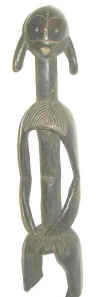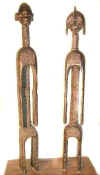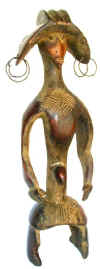 |
 |
|||
 |
 |
 |
 |
|
 |
 |
 |
 |
 |
TRIBAL AFRICAN ART
MUMUYE (MUMOYE)
Nigeria and Cameroon
The Mumuye
mostly live in northeastern Nigeria between the cities of Jalingo and Zinna, in a region
that is bounded by the bend of the Benue River and the Cameroon border. Estimated to
number 70,000 to 400,000 the people cultivate sorghum, millet, and yams. Socially
they are divided into small family groups called dola, which are
headed by a council of elders with an elected leader. Due to the difficulty of
access to their land of rocky hills and savannas, the Mumuye remained in near total
isolation until 1959. Mumuye artists are famous for their wooden statues known as iagalagana.
The Mumuye statuary was discovered in 1968. With no royal system, the Mumuye are
organized by age classes and choose a village chief who is assisted by a council of
elders. The vabong secret society regulates Mumuye religious life. Entry into the
society is achieved through initiation ceremonies. The initiation of boys begins at the
age of ten and takes place in a tsafi hut, where the statues are kept. Even though
the Mumuye show great respect for the sculls of the ancestors, their statuary does not
depict ancestors, but rather incarnates tutelary spirits. Yet, statues reinforce the
status and prestige of their owner who, as he holds them in his hands, has a dialogue with
them and thus ensures his personal protection. The functions of sculptural figures
are varied. They were used by both diviners and healers, whose professions included
diagnosis and cure of ill health and other kinds of misfortunes. The figures were used to
greet rainmaker's clients, guard the house, serve as owner's confidant, and in
trials when men in dispute swear on the statue, which they must kiss. Elders used
them to reinforce their status in society. It was not unusual for a figure simultaneously
to serve two or more functions. The size of statues varies from 20 centimeters to
1.6 meters. Mumuye figures are highly abstracted, perhaps in part because they
invoke forms of human and supernatural authority.